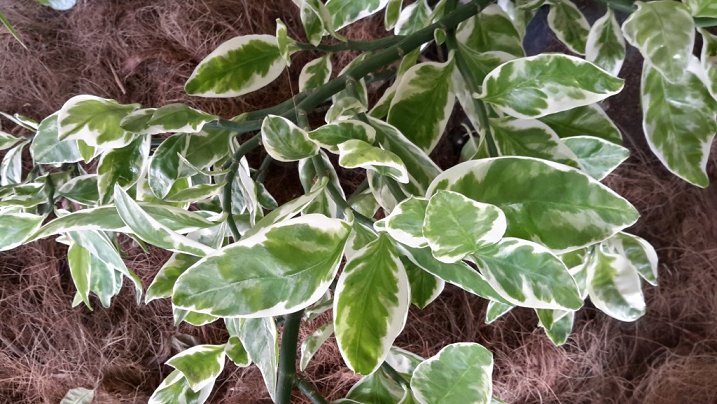By Tommy Clarkson on the September 2019 Edition
Family Pedilanthus tithymaloides ‘Variegatus’
Also known as Zig-Zag Plant, Christmas Candle,Redbird Cactus, Japanese Poinsettia, Slipper Spurge or Slipper Flower
One seldom encounters plants with multiple names as diverse in their inferred representation/description!
Those familiar with me are well aware of my great appreciation for the patient friendship and sage, botanical counsel provided to me by Dr. Mark Olson of the Institute of Biology at the Uni-versity of Mexico, Ander Lindstrom of Nongnooch Tropical Gar-dens near Pattaya Thailand, Barry Fugatt of the Linnaeus Teach-ing Gardens in Tulsa, Oklahoma, and renowned tropical plant author and lecturer, Dr. Art Whistler from Hawaii. These gentle-men are true botanists of the highest order not “dabble in the dirt” or “muddle in the mud” sorts such as me – and I will, forever, be in their debt for their many kindnesses!
The first of these professionals, Dr. Mark Olson, shared that this is “native to Mexico (common in the southern Isthmus of Tehuantepec area), into Central America and the Caribbean islands. Here, in Mexico, you can find people call it zapatito de la virgen or zapatito del diablo. But more pertinent is it to note that the genus, Pedilanthus, no longer exists with the entire clade now subsumed into Euphorbia. The clade, of thirteen species, are all found in Mexico.

In fact, there is one species found near Ola Brisa Gardens on the pass going to Colima – P. calcaratus /E. calcarata; one endemic to the dry side of the Manantlán which is very close to us, just into Jalisco – E. diazlunana; another common in moister, mid-elevation areas in Nayarit and Jalisco and probably Colima and down through Guererro E. peritropoides with amazing dangling duck-like inflorescences; one completely endemic to Jalisco from El Tuito up into the Sierra de Cacoma in the area of Desmoronado – E. colligata; and yet another endemic, the amazing tree, E. coalcomanensis, from near Coalcomán in Mi-choacán not far from the Colima border. So, you are near an epicenter of Pedilanthus clade diversity.
In turn, and more plant-specifically, as written by the latter of these individuals, regarding the Pedilanthus tithymaloides, Dr. Art Whistler noted in his book, “Tropical Ornamentals,” that the Devil’s Backbone “is widely cultivated for its red cyathia (a cup-like, highly reduced inflorescence).”
As one of its names implies, this plant’s thick, rubbery, green and white stems grow back and forth between each leaf in a zigzag manner. Attached to them are alternating, never segmented, green and white variegated leaves that take on a rosy blush in bright, sunny conditions. That latter name Slipper Flower is derived from the fact that its flowers are thought to look somewhat like such. Pedilanthus is from the Greek word meaning both “shoe” and “flower.” (Why do I think that in ancient Greece one had to be wary of someone’s request to smell their pedilanthus?)

It can be grown as a landscape plant, maturing into a shrub from six to eight feet (2-2.5 meters) tall. Indoors, they seldom bloom, but are enjoyed for their beautiful form and colorful foliage. However, regardless of where sited, keep in mind that all parts of this plant contain a milky sap that can irritate one’s skin and could well be rather harmful if ingested. So, locate the plant where it won’t be in contact with overly explorative children and pets that long overstaying house guest, however, may be an entirely different issue! I encourage the wearing of garden gloves when pruning its stems or transplanting to avoid possible, discomforting, skin irritation.
The Pedilanthus tithymaloides seeks a bright location. In our environs, it makes an attractive deck or patio specimen and, on the whole, is a useful landscape plant in virtually all frost-free climates. They’re easy to grow. Ensconce (what a wonderful word!) it in a well-drained potting mix for cacti and succulents. Apply a balanced liquid fertilizer monthly during active growth; and water once a week.
In the wild, bright light and perfect conditions, it can reach a height of ten feet (3.04 meters) but, more often, “in captivity,” it may stay around four to six feet (1.22-1.83 meters) high and that or a bit more in width. Provide a bright location indoors or a sunny to partly shaded location outside. The Devil’s Back-bone requires no support nor rigid truss (a poor attempt at osteogenetic humor there) but does seek well-draining soil and minimal watering – just once a week is usually adequate. Prune freely to maintain size and shape.
The full edition or view it online
—
Tommy Clarkson is a bit of a renaissance man. He’s lived and worked in locales as disparate as the 1.2 square mile island of Kwajalein to war-torn Iraq, from aboard he and Patty’s boat berthed out of Sea Bright, NJ to Thailand, Germany, Hawaii and Viet Nam; He’s taught classes and courses on creative writing and mass communications from the elementary grades to graduate level; He’s spoken to a wide array of meetings, conferences and assemblages on topics as varied as Buddhism, strategic marketing and tropical plants; In the latter category he and Patty’s recently book, “The Civilized Jungle” – written for the lay gardener – has been heralded as “the best tropical plant book in the last ten years”; And, according to Trip Advisor, their spectacular tropical creation – Ola Brisa Gardens – is the “Number One Tour destination in Manzanillo”.



